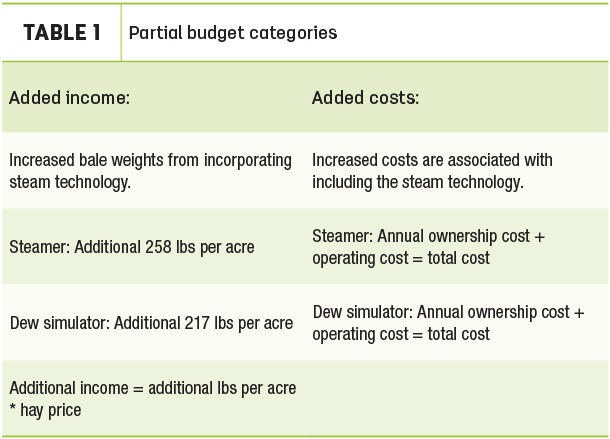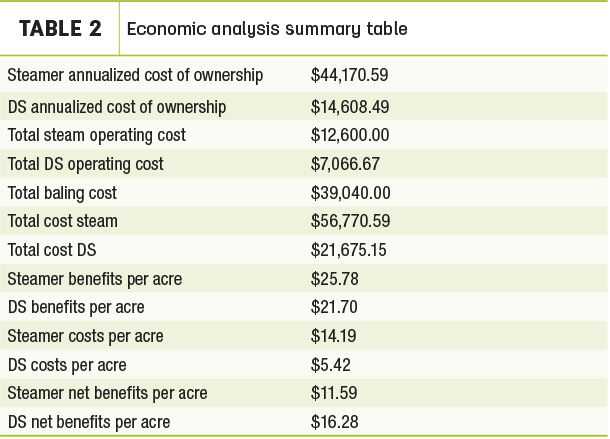Having the correct amount of moisture in harvested alfalfa at the time of baling is critical to maximizing economic return. In many of the areas of the western U.S., moisture levels of alfalfa hay in the windrow can dry to the point that leaves and stems will shatter during the baling process. As a result, producers typically bale at night and early morning, relying on dew to provide needed moisture.
In recent years, equipment that injects moisture into the windrow during the baling process has created an option for producers to bale when natural dew is not present. Utah State University conducted a research study during the 2020 growing season on a producer’s farm near Milford, Utah. A steamer and dew simulator were utilized for the research. Bales were weighed and tested for neutral detergent fiber (NDF), acid detergent fiber (ADF), relative feed value (RFV) and crude protein (CP).
Partial budgeting
The economic analysis of these different remoisturizing alfalfa technologies utilizes only variables that were statistically significant. In this analysis, bale weight was the variable found to be statistically significant. The average bale weight from the two cuttings for the dry bale was 1,361.5 pounds, the dew simulator was 1,443, and the steamer was 1,490. The dew simulator averaged an 82-pound difference and the steamer a 129-pound difference in bale weights. Based on the trial data which averaged 1.79 bales per acre, we estimate that the steamer will have an additional 258 pounds per acre and the dew simulator an additional 217 pounds per acre.
Partial budgeting is an economic decision tool to help analyze financial impacts of changes to an operation. Partial budgeting only includes resources that will change such as adding remoisturizing technology in an alfalfa operation. The cost of baling will remain fixed, and the financial impact of including remoisturizing technology will be analyzed.
The four key components to a partial budget are increased income, reduction or elimination of costs, increased costs and reduction or elimination of income. The net impact will be the positive changes minus the negative changes. Table 1 helps to identify these changes.

Economic analysis
Annual ownership cost is estimated by utilizing the capital recovery method. The capital recovery method utilizes the purchase price, salvage value, useful life and a discount rate to estimate the annual ownership cost. A five-year useful life was assumed for both pieces of equipment. The discount rate represents the opportunity cost of capital and accounts for owning the piece of equipment over multiple future periods.
Table 2 illustrates the ownership costs for the steamer and dew simulator.

The steamer has a higher initial cost and, consequently, a higher annual ownership cost. The operating cost is estimated by utilizing the fuel used per hour, labor cost and repair costs on an annual basis.
Utilizing the information from Table 1, we can analyze the net financial impact assuming 1,000 acres of alfalfa, a fuel price of $2.50 per gallon and an alfalfa price of $200 per ton.
Apply the results
Based on the defined scenario, the steamer has a $11.59 net benefit per acre, and the dew simulator has a $16.28 net benefit per acre. These numbers are based on one certain scenario, so caution must be used when drawing specific conclusions from them. The steamer has a higher ownership cost, which drives the cost per acre up. One key to understanding this investment is: This cost is reduced as the number of acres increases. These results also assume that both steam technologies are utilized over 100% of the acres. Decreasing the usage will impact the results for both technologies. A producer should utilize the partial budgeting methodology to analyze the results for their specific operation.
There is no one-size-fits-all for these technologies. Other factors could influence the decision to purchase either one of these remoisturizing technologies. Geographic region and size of operation would play a major role in analyzing adoption of either one of these technologies. Alfalfa producers must analyze the length of their baling window and dew levels.
Producers should also analyze where their alfalfa is marketed. If a producer markets premium alfalfa versus fair to low-quality alfalfa, the returns to either one of these technologies will be different. Another key consideration is the addition of debt to purchase the equipment. Producers should carefully assess the implications of additional debt to their operations.








